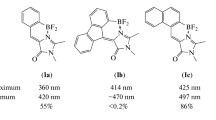Abstract
We propose to use the conformationally locked GFP chromophore derivatives (4-(2(difluoroboryl)benzylidene)-1H-imidazol-5(4H)-ones) as potential fluorescent sensors. The model carbamate derivatives were synthesized and their fluorescent properties were studied. It was shown that the introduction/cleavage of the carbamate groups at the nitrogen atom led to the noticeable shifts in the absorption and emission maxima of the resultant derivatives, which makes them promising candidates for new fluorescent sensors.
Similar content being viewed by others
Abbreviations
- GFP:
-
green fluorescent protein
- THF:
-
tetrahydrofuran
References
Ivashkin, P.E., Yampolsky, I.V., and Lukyanov, K.A., Russ. J. Bioorg. Chem., 2009, vol. 35, pp. 652–669.
Yuan, L., Chen, H., Zhu, S., and He, L., Angew. Chem., Int. Ed. Engl., 2013, vol. 52, pp. 10018–10022.
Fery-Forgues, S., Veesler, S., Fellows, W., Tolbert, L.M., and Solntsev, K.M., Langmuir, 2013, vol. 29, pp. 14718–14727.
Deng, H., Zhu, Q., Wang, D., Tu, C., Zhu, B., and Zhu, X., Polym. Chem., 2012, vol. 3, pp. 1975–1977.
Baranov, M.S., Lukyanov, K.A., Borissova, A.O., Shamir, J., Kosenkov, D., Slipchenko, L.V., Tolbert, L.M., Yampolsky, I.V., and Solntsev, K.M., J. Am. Chem. Soc., 2012, vol. 134, pp. 6025–6032.
Baranov, M.S., Solntsev, K.M., Baleeva, N.S., Mishin, A.S., Lukyanov, K.A., and Yampolsky, I.V., Chem.-Eur. J., 2014, vol. 20, pp. 13234–13241.
Frizler, M., Yampolsky, I.V., Baranov, M.S., Stirnberga, M., and Gutschow, M., Org. Biomol. Chem., 2013, vol. 11, pp. 5913–5921.
Chung, C., Srikun, D., Lim, C.S., Chang, C.J., and Cho, B.R., Chem. Commun., 2011, vol. 47, pp. 9618–9620.
Peng, H., Chen, W., Cheng, Y., Hakuna, L., Strongin, R., and Wang, B., Sensors, 2012, vol. 12, pp. 15907–15946.
Basabe-Desmonts, L., Reinhoudta, D.N., and Crego-Calama, M., Chem. Soc. Rev., 2007, vol. 36, pp. 993–1017.
Author information
Authors and Affiliations
Corresponding author
Additional information
Original Russian Text © N.S. Baleeva, I.V. Yampolsky, M.S. Baranov, 2016, published in Bioorganicheskaya Khimiya, 2016, Vol. 42, No. 4, pp. 501–504.
Rights and permissions
About this article
Cite this article
Baleeva, N.S., Yampolsky, I.V. & Baranov, M.S. Conformationally locked GFP chromophore derivatives as potential fluorescent sensors. Russ J Bioorg Chem 42, 453–456 (2016). https://doi.org/10.1134/S1068162016040051
Received:
Accepted:
Published:
Issue Date:
DOI: https://doi.org/10.1134/S1068162016040051




